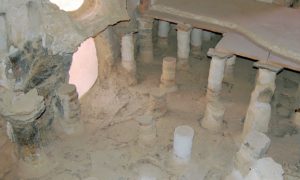
Heated Floor in Masada’s Bath House (Photos by Don and Jen Knebel)
In 37 B.C., the Roman Senate appointed Herod the King of Judea, a position he held until he died in 4 B.C. Known to Christians for ordering the killing of male babies in Bethlehem at the time of the birth of Jesus, Herod is known to history for his massive building projects, including the reconstruction of the Jewish Temple in Jerusalem and an artificial harbor on the Mediterranean coast named Caesarea Maritima.
To protect himself and his royal entourage from the constant threat of insurrection, Herod built a number of fortresses around his kingdom, the most famous one at Masada. Atop this isolated and rocky plateau in the Judean desert, then reachable only by a winding narrow path, Herod built two palaces, the northern one a three-tiered structure more than 100 feet tall offering a spectacular view of the Dead Sea. Near his palaces, Herod constructed a four-room Roman bath. After changing clothes in a room richly decorated with frescoes, royal bathers entered a room where air heated in a furnace was blown beneath a floor supported on posts, heating the entire room and causing bathers to perspire. After entering an adjoining room where they were scrubbed clean and oiled by slaves, bathers entered the final room, where they doused themselves in a pool of cold water.
Masada was named a UNESCO World Heritage site in 2001. Today, Masada’s bath complex has been partially restored and models show how it looked during the time of King Herod. Visitors not wanting to climb the so-called “Snake Path” to the top can ride a cable car.
Comments are closed.